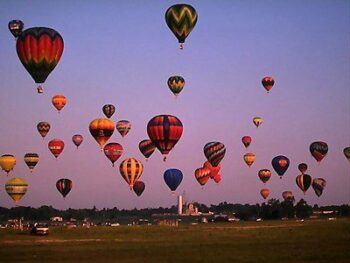
On the other hand, I can grasp a work of art; there I can find—if I may so put it—that Archimedean point, and once I’ve found that, everything easily becomes clear to me.
—Soren Kierkegaard, Papers and Journals: A Selection
***
The students were instructed to trim their fingernails and remove sharp hairpins before beginning the project. Their young hands moved quickly; smooth and dexterous fingers flitted, taking care to avoid tearing the fragile washi that would soon form Technicolor-bright envelopes on handcrafted hot-air balloons. Working together, these mid-twentieth-century Japanese schoolchildren assembled the balloons, meticulously grafting the wafery squares together using konnyaku-nori, a paste made from a potato known in the country as “devil’s tongue.” Washi paper, derived from the kozo, or mulberry bush, is a thin and delicate material used for such arts and crafts; origami, lanterns, and papier maché sculptures take shape when the brightly colored paper is folded, cut, or glued. The ambitious balloon project left the children’s workspace covered in washi confetti; cleaning up the paper bits—lurking in chairs’ crevices, stuck between carpet fibers—required nearly as much delicacy as pasting them together.
***
Constructing my own personal aircraft from household materials became an ongoing childhood project, revisited each time I acquired a more solid skill set or knowledge base. As such, it also provided an endlessly renewable source of exposure to the sting of persistent failure. My efforts routinely thwarted by malfunctioning cardboard wings, heavy refrigerator-box space shuttles, tattletale siblings, and the dearth of aviation and mechanical manuals suitable for children, I remained unflappable, refusing to admit defeat. Instead, I’d comb through my favorite Childcraft Encyclopedia: The World and Space, searching for detailed instructions with which I might construct a hot-air balloon like the one that graced the encyclopedia’s cover.
A man pedaled a bicycle through space, an attached propeller pushing him further, a tilted umbrella fixed behind him. The man’s energy and space’s lack of gravity combined to support a yellow-fringed balloon adorned with harlequin diamonds. Six space-suited astronauts crowded the suspended basket, observing a satellite approaching a glowing, ringed Saturn in the background. Sandbags dangled from the balloon’s basket, which was attached to the bicycle by a cartoon steel pole.
My 1987 edition of The World and Space managed to join the two spheres on its multicolored cover, filling in the gaps of physics with imagination, and convincing my four-year-old brain it could do the same—with a little help, of course. But neither description nor instruction appeared within those pages. Building a balloon that might travel to the stratosphere, or beyond it, proved utterly impossible, despite what the book’s clever illustration implied. Air apparently does not qualify as world or space.
As my limited knowledge of the mechanics of flight became apparent, and the realization struck that pesky gravity and biology would prevent its natural occurrence, I, like most children, used fantasy, delirium, and dreams to take flight.
I relished my recurring fevers—and their accompanying hallucinations—for the opportunity to watch an endless parade of hot-air balloons, each bearing a letter from the alphabet, approach from my room’s corner, each beginning a slow descent as it neared my narrowing vision. This lucky hallucination comforted me. I no longer wished for the ability to fly; I wanted to know, outside of my bed, what it felt like to build or be on things that couldn’t crash—things that provided ample time to prepare for landing, time to adjust to the disappointment of coming down.
Had I understood basic physics (hot air rises), I could’ve been my generation’s “Balloon Girl,” launching from my backyard as my parents slept, looking down on neighborhood pools, knowing that the worst that could happen would be landing in one of them (my basket conveniently becoming a sailboat), eventually touching ground safely to dock my balloon in an imaginary hangar.
Finally, I didn’t need to rely on chicken pox or imagination to experience the fuzzy calm that accompanies both hot air balloon rides and fever. My best friend introduced me to adventures I wouldn’t ordinarily pursue—things like horseback riding—that my parents warned me were much too dangerous to experience beyond a book’s binding or delirium’s haze, even for adults.
One fall morning, we rose before dawn and drove bleary-eyed with my friend’s father down still-silent streets to a field where, in the company of other enthusiasts, we hitched a patchwork vinyl blanket to a basket, turned on the heat, and set sail. I think.
The previous night, I fell asleep in my friend’s hunter-green room, marveling at her vast collection of plastic horses, jealous of the first-prize ribbons hung around their necks, evidence that she regularly outsmarted danger.
I’m not sure I informed my parents that we’d attend my town’s annual hot-air balloon festival the next morning. This excursion was a transgression, one that I’m not convinced actually occurred. Perhaps I created this memory and clung to it because I wasn’t a child who took many chances. I took ballet and piano lessons while my friend groomed and raced thoroughbreds. I read and calculated, creating games like “Office,” and building forts for the express purpose of reading, undisturbed, beneath them.
Some combination of dreams, delirium, actual experience, and sheer desire combined to form a memory accessible in myriad situations. When I ride roller coasters, I know that the feeling I get during a steep drop—my body standing and pushing forward without consent or intention—is the same as the one I experienced when crewmembers released the tethers from the balloon. I feel it in elevators too, my knees buckling at the initial lift, my guts rising.
***
The science behind hot-air balloons is actually quite simple, and though there have been countless technological advances since pre-modern China used floating Kongming lanterns as military signals, the lighter-than-air industry continues to honor the craft’s traditions, slightly tweaking the already existing apparatus only to increase safety and efficiency.
In September 1783, Jean-François Pilatre de Rozier sent a duck, a rooster, and a sheep into the air in his homemade balloon, which floated for fifteen minutes before crashing back to the earth. The animals escaped the fall with minor scratches, and de Rozier effectively launched with those unsuspecting pilots the race to conquer the sky, and the conviction that it was possible. Two months later, King Louis XVI of France decreed that condemned criminals would pilot the first manned hot air balloon launch. But on November 21, de Rozier and François Laurent d’Arlandes petitioned for, and were granted, the honor of ascending in a balloon crafted by brothers Joseph and Etienne Montgolfier. The scientist and his copilot floated for twenty minutes, becoming the first documented humans to experience sustained flight.
Ever ambitious, de Rozier attempted to cross the English Channel in 1785 by tying a hydrogen balloon to the traditional hot-air variety. He was killed when his craft exploded half an hour after takeoff. Significantly lighter than air, hydrogen, discovered in 1774, would propel the balloon much more quickly than hot air alone, but the fatal consequences of its flammability led to its abandonment. Today, hybrid balloons named for Rozier use a combination of helium and hot air to ascend more quickly and prolong flight.
Hot-air balloons aren’t actually propelled in the usual sense. They rise, of course, but cannot move laterally in any direction without the wind’s assistance. The pilot must pull a rope attached to a valve at the top of the balloon to descend into a desirable current. Likewise, closing the valve will cause the balloon to ascend, potentially happening upon a wind mass heading an entirely different direction. Efficient travel requires an experienced pilot, accommodating weather conditions, and a passenger who possesses a nuanced conception of control—someone accustomed to, or seeking out, unreliability. Based on their inability to control horizontal speed and their inherently slow rate of vertical change, the Federal Aviation Administration grants hot-air balloons the right of way in air traffic, unless a nearby aircraft is experiencing an emergency. In a crowd of balloons, the bottom balloon has the privilege as it often cannot see above its envelope nor can it quickly descend. Though incidents rarely occur, when hot-air balloon envelopes do collide without catching fire or crashing, it is called a “kiss.”
Often described as mystical, romantic, awe-inspiring, or hopeful, the iconic balloons continue to inspire children and adults alike continue to ascribe meaning and attach significance to them. Inspirational posters feature balloons with “reach for the sky” type messages, and they work, especially for children. Who doesn’t want to believe that seemingly magical experiences or achievements are indeed possible? Originally designed for transportation, hot-air ballooning, since the middle of the twentieth century, has evolved into a legitimate and competitive sport, as well as a recreational and commemorative or celebratory activity. Couples get engaged or married in flight, and champagne toasts follow every ride, whether routine or monumental.
Balloonists are athlete-adventurers, breaking speed, altitude, and distance records, and in one case, the sound barrier. In 2002, Steve Fosset circumnavigated the globe alone in a closet-sized gondola, sleeping every four hours in forty-five minute shifts for fifteen days. Though air is neither world nor space, it still acts as a sort of final frontier, challenging pilots like Bobby Sparks—who attempted to cross the Atlantic Ocean several times in the 1970s, each time landing in its icy waters and requiring rescue—to continue wrestling with elements beyond one’s control to reach a goal or set a standard.
Jules Durouf rose above a besieged Paris on September 23, 1870, in Le Neptune, carrying 227 pounds of mail penned within the city’s walls in an effort to communicate with the outside world and with France’s provisional government at Tours. During the siege on Paris in the Franco-Prussian War, sixty-six balloons were constructed and released from Paris under the cover of night, transporting over two million pounds of mail, 500 return-mail carrier pigeons, 102 humans, and five dogs. Fifty-eight balloons landed safely, the last of which carried news of the Armistice. Because of the balloon campaign’s success in preserving communication, and thus hope, the Commission des Communications Aeriennes was established in 1874 and still exists today.
Hot-air balloons seem to represent or elicit a sense of wonder actually based on historical evidence and the object’s frequent use as a positive symbol. From this vantage point, they seem worthy of an untainted and iconic status. Elements of hope, romance, communication, and success inspire reflection. The continual urge to perform the kind of reconnaissance that ballooning facilitates—to keep searching from above for hope and perspective—is only natural. But the implicit contract one agrees to when adopting a bird’s-eye view requires the acceptance that the panoramic lens inevitably includes smaller, and perhaps unsightly, components, which upon further inspection seem sinister—elements that complicate and potentially corrupt those once spectacular views.
***
 Jules Verne’s 1873 adventure novel, Around the World in Eighty Days, is commonly associated with the iconic image of a hot-air balloon (its cover, like my Childcraft Encyclopedia, often features one), but only briefly mentions the aircraft when describing its lack of amenability to such large-scale travel. Five Weeks in a Balloon, Verne’s first novel, published in 1863, describes an excursion to Africa in a hydrogen-powered balloon. Three Frenchmen look down, literally and figuratively, upon a continent primed for exploitation.
Jules Verne’s 1873 adventure novel, Around the World in Eighty Days, is commonly associated with the iconic image of a hot-air balloon (its cover, like my Childcraft Encyclopedia, often features one), but only briefly mentions the aircraft when describing its lack of amenability to such large-scale travel. Five Weeks in a Balloon, Verne’s first novel, published in 1863, describes an excursion to Africa in a hydrogen-powered balloon. Three Frenchmen look down, literally and figuratively, upon a continent primed for exploitation.
Aerial views allowed Thaddeus Lowe’s Union Army Balloon Corps to spot Confederate soldiers. On Lowe’s command, Union soldiers fired weapons accurately without seeing their targets. Hot-air balloons revolutionized mapmaking and military intelligence acquisition, but they also changed how we fight. Austrian soldiers launched two hundred pilotless balloons carrying fuse-timed bombs in the direction of Venice, but became the recipients of the bomb barrage when the wind unpredictably changed directions.
Upon discovering a jet stream that would carry balloons across the Pacific Ocean to the United States’ West Coast, the Japanese army, during World War II, filled amphitheaters and concert halls with schoolchildren, forcing them to construct ten thousand balloons from vibrantly colored bits of washi paper that would be filled with hydrogen and launched in hopes of starting forest fires in the Pacific Northwest. Due to the region’s wetness, the balloons, launched during the rainy season between November 1944 and March 1945, had little effect, and the CIA, suspecting attempted germ warfare, prohibited the press from distributing news of the attack in order to prevent hysteria. Because of this censorship, one woman and five children were instantly killed after discovering a balloon, curiously tugging on its cord, and detonating it during a picnic in Oregon’s woods. Today, a plaque commemorates the site as “the only place on the American continent where death resulted from enemy action during World War II.” Only 285 of these miniature hydrogen bombs, scattered as far as Alaska, Minnesota, and New Mexico, have been found.
***
Recently, while digging through castoffs and collectibles on the attic-like second floor of an antique shop—searching for potential treasures among the rubble and relics of culture, technology, and time—I found, wedged between plastic crates brimming with old jazz records, a set of Time-Life’s The Epic of Flight series. The collection, originally comprising twenty-three volumes, had been picked over, rummaged through by shoppers like me—those seeking some tangible reminder of history lived or imagined or learned, something to put on a shelf to make the past a little less hazy, a little more present.
Eight volumes remained, each priced at $3.99. I ran my finger across the blue leatherette spines, across silver-embossed titles like Women Aloft and Barnstormers and Speed Kings, until it landed on The Aeronauts. I plucked the book from the set and studied its cover, which features two watercolor-style hot-air balloons floating through cumulus clouds. I felt that familiar gut-punch. This book, published in 1981, had provided all the answers to my childhood questions, a more complete history than I could have imagined, before I was even born.
Thumping down the carpeted, creaking stairs, I realized that buying only this volume would mean accepting that while I might come closer to filling in the gaps of my imagination with physics, history, and artifacts, I’d also assume responsibility for creating a bigger hole for shoppers who aren’t like me—those who want the complete set, those who won’t settle for scavenging only bits of individual truth from the wreckage of our collective past, those who want to believe that if you put twenty-three alphabetized volumes on a shelf, you’re more likely to see the bigger picture, and feel good about it. I bought the single volume anyway.
***
For twenty years, I have chosen to believe in the mystic truth of my own ballooning memory, calling it forth as a reminder of lived euphoria and using it to cultivate a daredevil spirit. You’ve ridden in a hot-air balloon, my memory reminds me. You can do anything. Though it is a memory likely as fabricated, embellished, and incomplete as the history of ballooning itself—as filled with fissures and cracks as the lonely and dwindling The Epic of Flight series nestled among other antique misfits—I cannot discard it.
That morning, years ago, I saw the balloons inflate, watched the air they displaced, condensing, sinking, flattening the long grass in which the gondolas hid. I climbed into a basket, looked up into the expanding balloon. Eventually, I couldn’t see beyond the collection of inflated envelopes. Neither field nor sky, world nor space, existed as the whirring propane burners broke the silence of morning.
***
Listen to Andrea read her essay:




